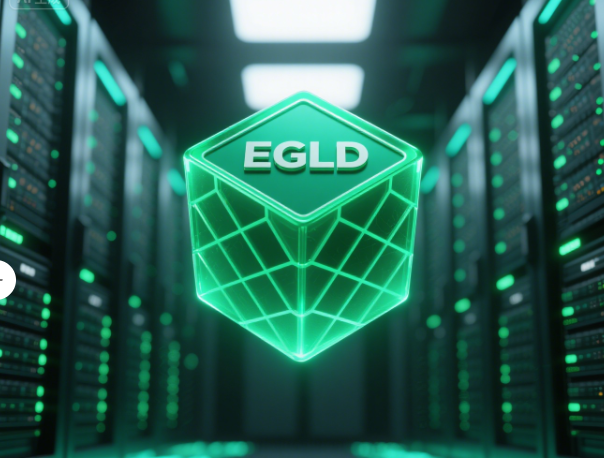Featured News
EGLD's Role in Web3 Infrastructure: Can Elrond's Native Token Power the Next Internet Era?
2025/06/06 07: 32
EGLD, the native token of MultiversX (formerly Elrond), emerges as a frontrunner in the Web3 arms race. With ultra-fast throughput and a sharding-based architecture
As the demand for faster, scalable, and secure blockchain infrastructure intensifies, EGLD, the native token of MultiversX (formerly Elrond), emerges as a frontrunner in the Web3 arms race. With ultra-fast throughput and a sharding-based architecture, EGLD is not just another cryptocurrency—it is an essential cog in the evolving machinery of decentralized technology. But what makes it truly stand out in a crowded crypto landscape?
The Backbone of a High-Throughput Blockchain
MultiversX, originally known as Elrond, rebranded in 2022 to better reflect its ambition to shape the metaverse and digital economies. At the heart of this transition is EGLD, a utility and governance token powering network fees, staking, and smart contracts.
What sets MultiversX apart is its use of Adaptive State Sharding, a mechanism that allows the network to split data and workload dynamically across different shards. According to a 2022 research paper from IEEE Access, this allows MultiversX to process over 15,000 transactions per second (TPS) with 6-second latency—figures that dwarf many competitors, including Ethereum’s ~30 TPS in its current state (IEEE Access, DOI:10.1109/ACCESS.2022.3145627).
This kind of scalability is crucial for real-world Web3 adoption, especially in areas like:
DeFi protocols where transaction speed is paramount
NFT marketplaces demanding real-time minting
Metaverse applications needing seamless interactions
Tokenomics That Reinforce Long-Term Utility
Unlike many altcoins with inflationary tendencies, EGLD features a deflationary model. The initial supply was 20 million tokens, and a decreasing emission schedule ensures scarcity, with a cap of 31,415,926 EGLD. Additionally, 30% of transaction fees are burned, directly reducing the circulating supply.
As per data from Messari (Q4 2023 report), EGLD’s staking ratio hovers above 80%, indicating high investor confidence and reduced liquid supply. This contributes to price stability and long-term value retention—a key concern among holders disillusioned by volatile, speculative assets.

Pain Points Solved: Security, UX, and Onboarding
User frustration often centers around high gas fees, slow transactions, and complex wallets. EGLD directly addresses these:
Ultra-low fees (~$0.001/transaction), even during high traffic
Maiar Wallet (now xPortal): An intuitive, social-focused mobile wallet designed for non-tech-savvy users. With over 1.5 million downloads, it simplifies onboarding by using phone numbers instead of seed phrases.
Furthermore, audit reports from CertiK and Runtime Verification verify the robustness of MultiversX’s codebase, offering additional peace of mind for developers and institutions.
Strategic Partnerships and Ecosystem Expansion
MultiversX isn’t operating in a vacuum. Strategic collaborations with giants like Samsung, Opera Browser, and Utrust bolster its adoption narrative. In a 2023 Medium post by MultiversX CEO Beniamin Mincu, he emphasized the goal to “integrate digital assets into everyday mobile experiences.” Initiatives such as the xLaunchpad, which incubates dApps on the EGLD blockchain, continue to grow the ecosystem and create real-world use cases.
According to Token Terminal, the network saw a 47% increase in active developers from Q1 2023 to Q1 2024, signaling strong community interest and technical expansion.
Market Performance and Future Outlook
Despite the broader crypto winter, EGLD has shown relative resilience. As of May 2025, EGLD trades around $47.20 with a market cap exceeding $1.2 billion (CoinGecko). While down from its 2021 highs, the token’s fundamentals and roadmap suggest significant room for long-term upside.
Analysts from Delphi Digital note that Layer-1 protocols with efficient sharding mechanisms and low fees are well-positioned to capture enterprise-level dApp deployment, especially as blockchain infrastructure becomes more intertwined with traditional tech stacks.
Final Thoughts: Is EGLD Undervalued?
EGLD's combination of technical innovation, real-world utility, and ecosystem growth addresses many of the pressing issues faced by users and developers alike. With a strong foundation in both architecture and adoption, EGLD is not merely surviving the bear market—it's building through it.
For investors seeking a project that offers scalability, security, and long-term viability in the Web3 space, EGLD deserves serious attention.
This article is brought to you by Coin78 — your gateway to curated blockchain insights and trusted crypto updates.
Author Bio
Dr. Nathan Lai is a blockchain analyst and fintech researcher with over a decade of experience in decentralized infrastructure. Holding a PhD in Computer Science from the University of Zurich, Nathan has consulted for both Web2 and Web3 enterprises on smart contract security, tokenomics, and digital identity. He frequently contributes to academic journals and speaks at global blockchain forums.
Disclaimer:
1. The information content does not constitute investment advice, investors should make independent decisions and bear their own risks
2. The copyright of this article belongs to the original author, and only represents the author's personal views, not the views or positions of Coin78. This article comes from news media and does not represent the views and positions of this website.
1. The information content does not constitute investment advice, investors should make independent decisions and bear their own risks
2. The copyright of this article belongs to the original author, and only represents the author's personal views, not the views or positions of Coin78. This article comes from news media and does not represent the views and positions of this website.
 USD
USD CNY
CNY HKD
HKD TWD
TWD VND
VND USDT
USDT